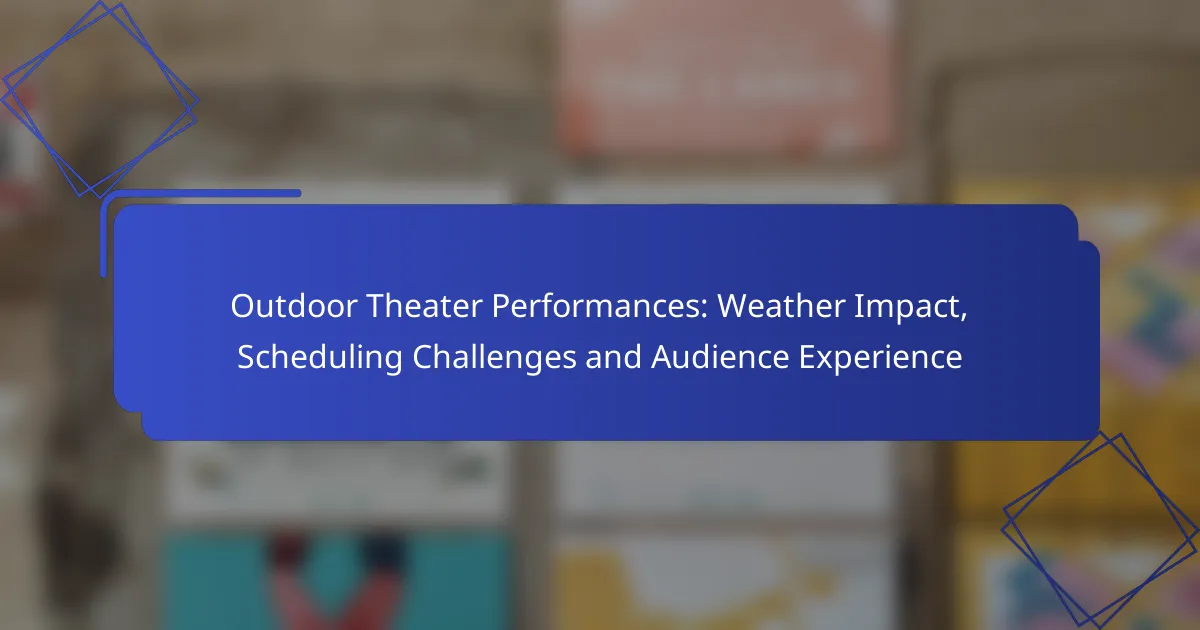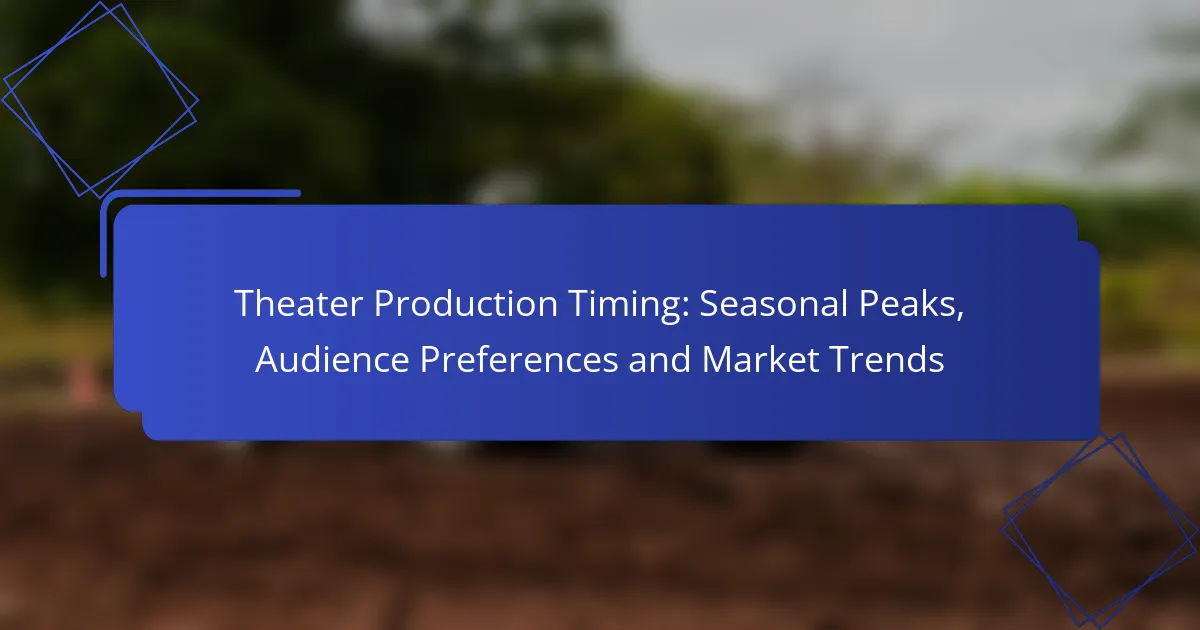Outdoor theater performances offer a unique blend of art and nature, but they are heavily influenced by weather conditions, which can impact scheduling and audience comfort. Rain, temperature fluctuations, and wind can lead to logistical challenges, requiring careful planning to ensure a successful event. Despite these hurdles, the outdoor setting can enhance the audience experience, making it a memorable occasion with the right amenities and atmosphere.
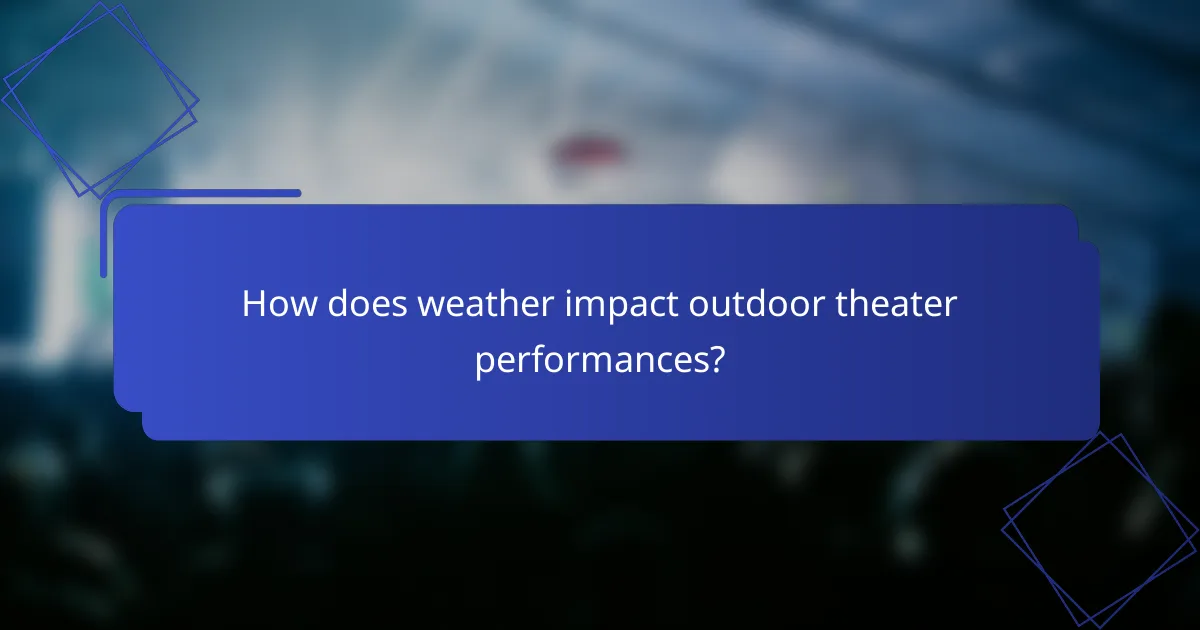
How does weather impact outdoor theater performances?
Weather significantly affects outdoor theater performances, influencing scheduling, audience comfort, and overall experience. Factors such as rain, temperature, and wind can lead to delays, cancellations, or diminished sound quality, all of which require careful planning and consideration.
Rain delays and cancellations
Rain can cause immediate delays or even cancellations of outdoor performances, as wet conditions pose safety risks for both performers and audience members. Many theaters have policies in place regarding rain, often allowing for rescheduling or refunds if a performance is canceled due to inclement weather.
Producers should monitor weather forecasts closely and communicate with audiences about potential changes. It’s advisable to have a backup plan, such as an indoor venue or alternative performance dates, to minimize disruptions.
Temperature effects on audience comfort
Extreme temperatures can impact audience enjoyment during outdoor performances. High heat can lead to discomfort, while cold weather may deter attendance or distract from the show. It’s essential to consider the average temperature range for the season when scheduling events.
Providing amenities like shaded areas, fans, or blankets can enhance comfort. Encouraging audiences to dress appropriately for the weather and offering hydration stations can also improve their experience.
Wind and sound quality issues
Wind can significantly affect sound quality during outdoor performances, causing audio to carry unevenly or become distorted. This can lead to a frustrating experience for both performers and the audience, as dialogue and music may not be clearly heard.
To mitigate wind issues, consider the venue’s layout and natural wind barriers. Using windshields for microphones and sound equipment can help maintain audio clarity. Testing sound levels before the performance starts is crucial to ensure optimal conditions.
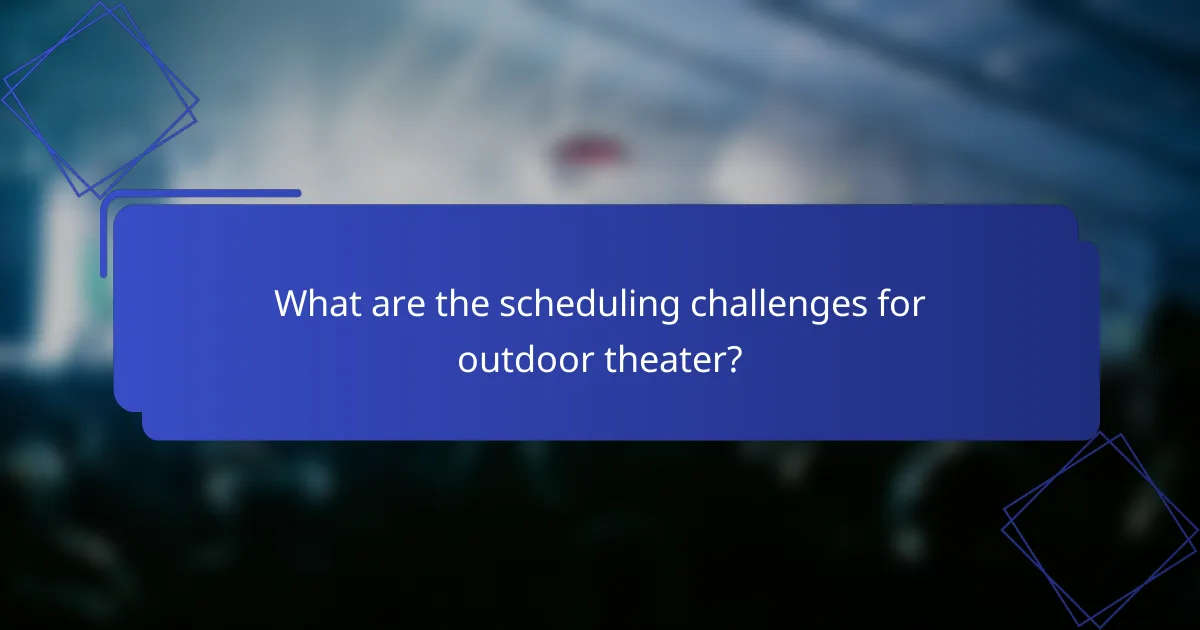
What are the scheduling challenges for outdoor theater?
Scheduling outdoor theater performances involves navigating various challenges, primarily influenced by weather conditions, venue availability, and local events. These factors can significantly impact the timing and success of a production.
Seasonal considerations
Seasonal changes greatly affect outdoor theater scheduling. Performances are typically more successful in warmer months, but this can vary by region; for instance, summer may be ideal in southern areas, while spring and early fall are preferable in cooler climates. Weather unpredictability, such as sudden rain or temperature drops, can lead to last-minute cancellations or rescheduling.
Producers should monitor long-term forecasts and consider historical weather patterns when planning. Utilizing weather insurance can also mitigate financial risks associated with weather-related disruptions.
Venue availability conflicts
Securing an outdoor venue can be challenging due to high demand, especially during peak seasons. Popular locations may be booked months in advance for festivals, concerts, or other events, limiting available dates for theater productions. It’s essential to start the venue booking process early to avoid conflicts.
Producers should maintain flexibility in their scheduling and have backup venues in mind. Establishing strong relationships with venue managers can also facilitate better access and priority for scheduling.
Coordination with local events
Local events can either enhance or hinder outdoor theater scheduling. Festivals, parades, and community gatherings can attract larger audiences but may also create competition for attendance. Understanding the local calendar is crucial for effective scheduling.
Producers should collaborate with local event organizers to avoid overlaps and potentially create joint marketing opportunities. Engaging with the community can also help in planning performances that complement local events, increasing overall audience turnout.
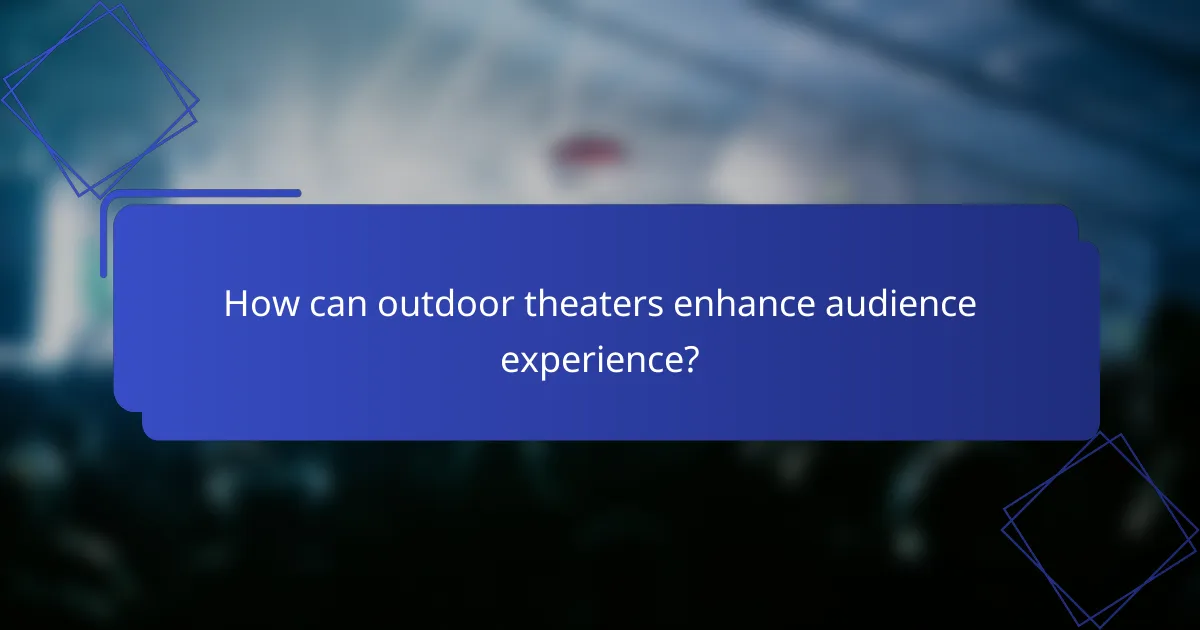
How can outdoor theaters enhance audience experience?
Outdoor theaters can significantly enhance audience experience by creating a unique atmosphere that combines performance art with natural surroundings. Key elements such as comfort amenities, interactive activities, and diverse food and beverage options contribute to a memorable outing.
Comfort amenities
Providing comfort amenities is essential for enhancing the audience experience at outdoor theaters. Comfortable seating, such as padded chairs or blankets, can make long performances more enjoyable. Additionally, offering shaded areas or heat lamps can help attendees stay comfortable regardless of the weather.
Consider providing access to restrooms and changing facilities, which are crucial for longer events. Offering designated areas for families or individuals with special needs can also improve accessibility and overall satisfaction.
Interactive pre-show activities
Interactive pre-show activities engage the audience and build excitement before the performance begins. These can include workshops, meet-and-greets with cast members, or themed games related to the show. Such activities create a sense of community and anticipation among attendees.
Consider scheduling these activities to start at least an hour before the performance. This allows ample time for audience members to participate without feeling rushed. Additionally, incorporating local artists or performers can enhance the cultural relevance of the event.
Food and beverage options
Offering a variety of food and beverage options can greatly enhance the outdoor theater experience. Local cuisine, gourmet snacks, and refreshing drinks cater to diverse tastes and preferences. Consider partnering with local vendors to provide unique offerings that reflect the community’s culture.
It’s beneficial to provide options for dietary restrictions, such as vegetarian, vegan, or gluten-free choices. Setting up food stalls or picnic areas can create a festive atmosphere and encourage social interaction among attendees. Ensure that pricing is reasonable to keep the experience accessible for all.
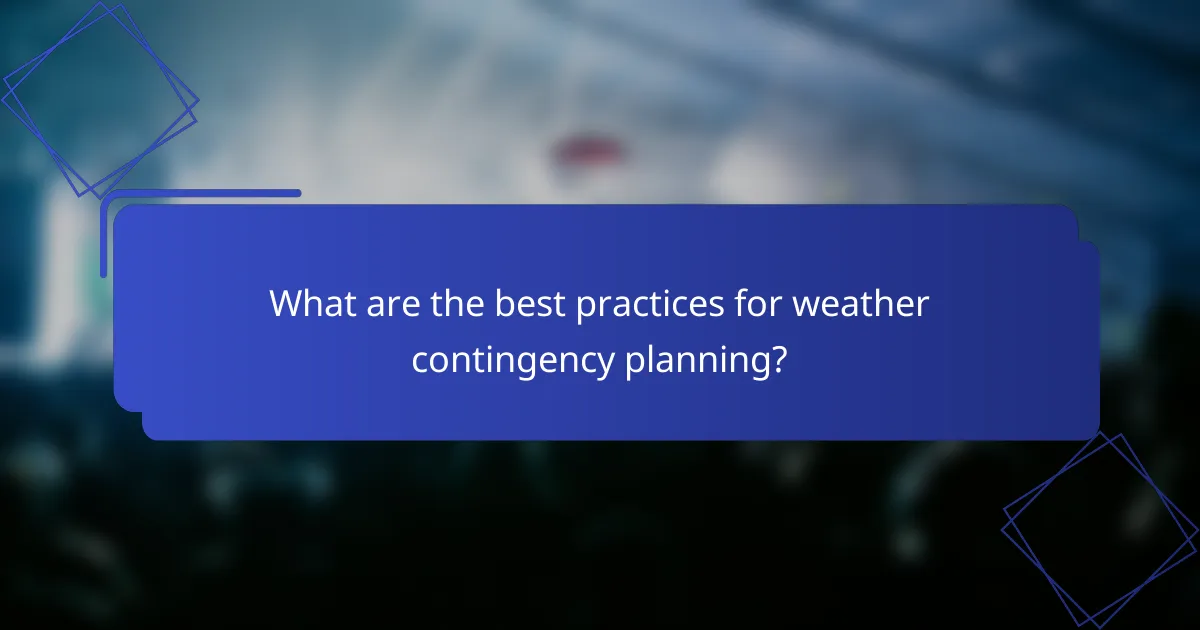
What are the best practices for weather contingency planning?
Effective weather contingency planning for outdoor theater performances involves preparing for various weather scenarios to ensure audience safety and satisfaction. Key practices include establishing communication channels, implementing flexible ticketing policies, and utilizing reliable weather forecasting tools.
Establishing clear communication channels
Clear communication is essential for informing audiences about any weather-related changes. Use multiple platforms such as social media, email newsletters, and your website to provide timely updates on performance status.
Consider designating a specific spokesperson or team responsible for communicating with the audience. This helps in delivering consistent messages and reduces confusion during unexpected weather events.
Flexible ticketing policies
Implementing flexible ticketing policies can enhance audience trust and attendance. Allow options for ticket exchanges or refunds in case of cancellations due to severe weather conditions.
For example, consider offering a grace period for ticket holders to reschedule their attendance or receive a full refund if a performance is postponed. This approach can encourage more people to purchase tickets, knowing they have options if the weather turns unfavorable.
Utilizing weather forecasting tools
Leveraging accurate weather forecasting tools is crucial for making informed decisions about outdoor performances. Use reliable weather apps or services that provide real-time updates and alerts for your specific location.
Establish a protocol for monitoring weather forecasts leading up to the event. This can include checking forecasts daily in the week before the performance and having a plan in place to act on alerts, such as moving the event indoors if necessary.
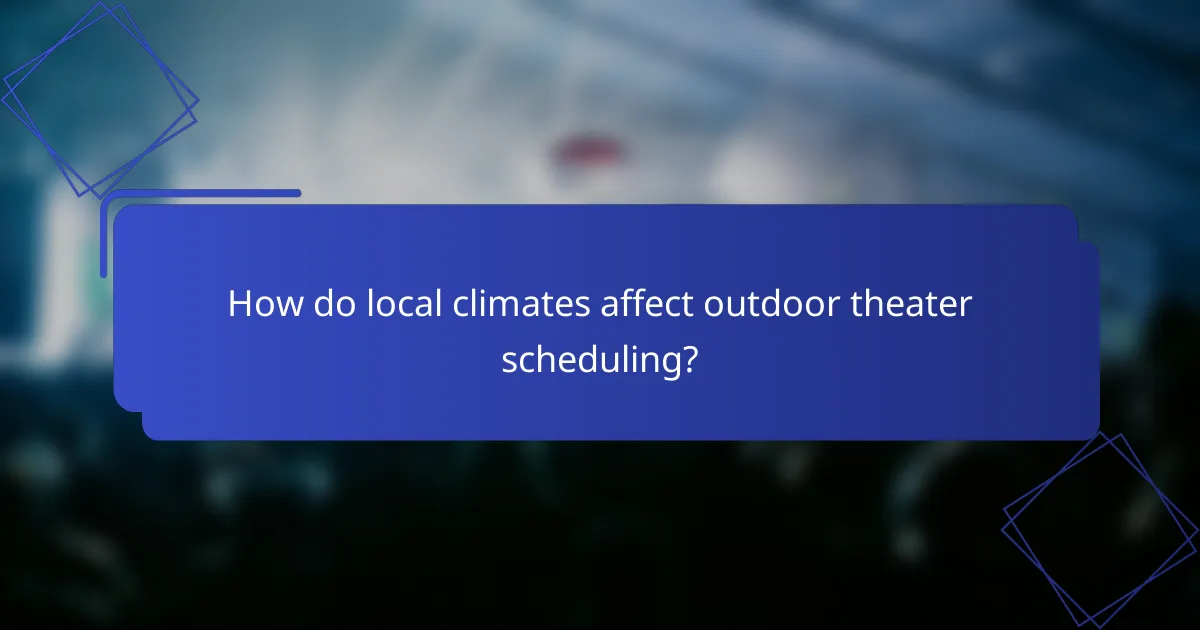
How do local climates affect outdoor theater scheduling?
Local climates significantly influence outdoor theater scheduling by determining the best times for performances and the types of weather-related challenges that may arise. Factors such as temperature, precipitation, and seasonal patterns must be carefully considered to ensure a successful audience experience.
Regional climate patterns
Regional climate patterns dictate the typical weather conditions for specific areas throughout the year. For instance, coastal regions may experience milder temperatures and higher humidity, while inland areas could face more extreme heat or cold. Understanding these patterns helps theater organizers choose optimal performance dates.
In areas with distinct wet and dry seasons, scheduling during the dry months can minimize the risk of rain interruptions. For example, outdoor theaters in Mediterranean climates often plan performances in late spring or early fall to avoid summer heat and winter rains.
Impact of seasonal festivals
Seasonal festivals can significantly impact outdoor theater scheduling by attracting larger audiences and creating competition for venues. For instance, summer festivals may coincide with local holidays or cultural events, making it essential for theater organizers to plan around these dates to maximize attendance.
Additionally, festivals often provide opportunities for collaboration, allowing theaters to participate in larger events. However, this can also mean that venues are booked well in advance, requiring careful planning and flexibility in scheduling.
Audience preferences in different weather
Audience preferences can vary greatly depending on the weather, influencing attendance and overall experience. Many people prefer attending performances during mild weather, such as spring or early fall, when temperatures are comfortable and the likelihood of rain is lower.
Organizers should consider providing amenities like shaded seating or heating for cooler nights to enhance audience comfort. Additionally, offering flexible ticket policies for weather-related cancellations can help maintain audience trust and encourage attendance despite unpredictable conditions.
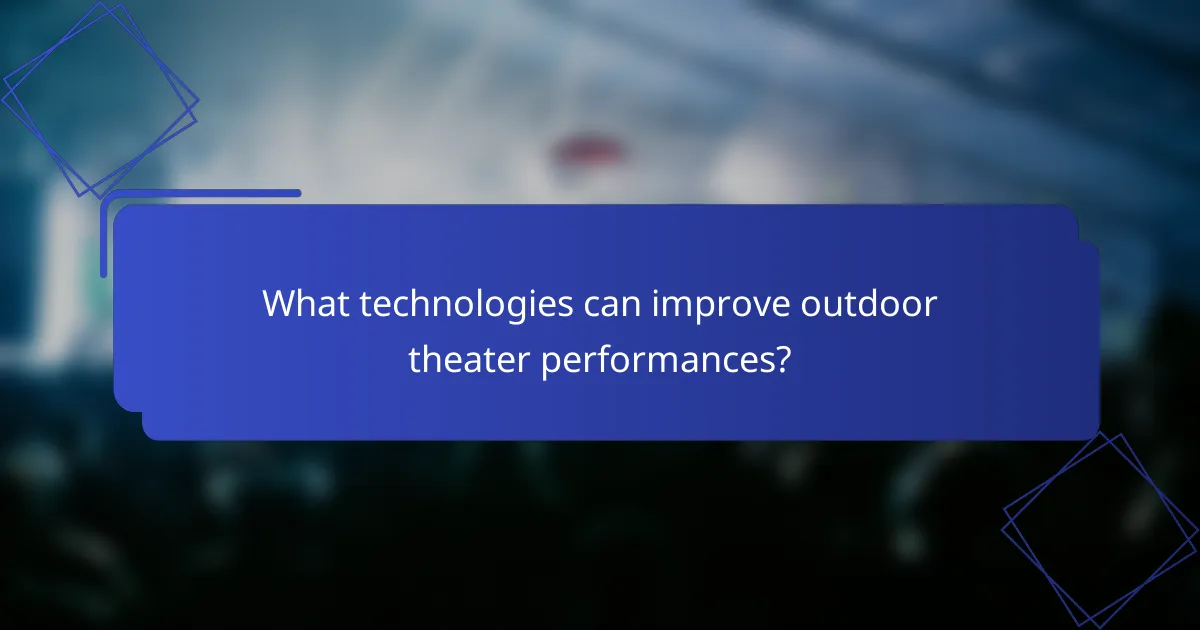
What technologies can improve outdoor theater performances?
Technologies that enhance outdoor theater performances focus on sound quality, stage durability, and audience comfort. Implementing the right systems can significantly elevate the overall experience for both performers and spectators.
Sound amplification systems
Sound amplification systems are crucial for ensuring that performances are heard clearly across large outdoor spaces. These systems typically include microphones, speakers, and mixers designed to distribute sound evenly, minimizing echoes and dead spots.
When selecting sound equipment, consider the venue size and audience capacity. For smaller gatherings, portable systems may suffice, while larger events might require professional-grade setups with multiple speakers positioned strategically. Always test the sound levels before the performance to avoid feedback issues.
Weather-resistant staging materials
Weather-resistant staging materials are essential for protecting performances from the elements. These materials include treated wood, metal, and synthetic composites that can withstand rain, wind, and sun exposure without deteriorating.
When planning an outdoor production, invest in high-quality staging that meets local weather conditions. For instance, in regions with high humidity, choose materials that resist mold and decay. Additionally, consider using tarps or covers to protect the stage during inclement weather, ensuring that performances can continue smoothly.
